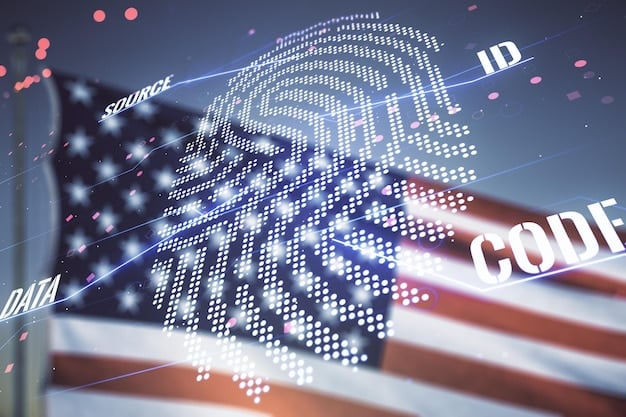How Technology is Shaping the Future of Voting in the US: Innovations & Challenges

The future of voting in the US is increasingly shaped by technological advancements, with innovations ranging from enhanced digital security to blockchain-based systems, all aimed at improving accessibility, efficiency, and integrity while addressing inherent challenges.
The democratic process, a cornerstone of society, constantly evolves, and at its heart lies the act of voting. As the world progresses, so too does the complexity and potential of technology. This raises a crucial question: How is Technology Shaping the Future of Voting in the US? A Look at the Latest Innovations reveals a landscape brimming with possibility and significant challenges. This exploration delves into the cutting-edge innovations poised to redefine how Americans cast their ballots, examining the intricate balance between progress and the vital need for security and trust.
The Digital Transformation of Elections: Beyond Paper Ballots
The idea of voting has historically been intertwined with paper ballots, physical polling places, and manual counting. However, as digital transformation permeates nearly every aspect of life, elections are not immune. The shift toward incorporating technology aims to address long-standing issues such as voter accessibility, the efficiency of vote counting, and the overall transparency of the electoral process. Innovations are pushing the boundaries, moving us far beyond the traditional paper trail.
Early Digital Systems and Their Evolution
Initial attempts at digital voting systems, often utilizing direct-recording electronic (DRE) machines, emerged with the promise of speed and accuracy. These early models allowed voters to cast their ballots directly onto an electronic device, with the results stored internally. While they offered benefits in terms of quick tabulation and reduced human error in counting, they also introduced new concerns regarding auditability and the potential for tampering without a verifiable paper trail. The absence of a paper record made recounts complex and the integrity of the vote difficult to confirm.
The Push for Verifiable Systems
Lessons learned from early DRE systems spurred a demand for verifiable paper audit trails (VPATs). This led to the development of machines that, while digital for user interaction, would print a paper record of the voter’s choices. This hybrid approach combines the ease of digital input with the security of a physical, auditable record. Such advancements represent a significant step in balancing technological convenience with the foundational requirement of transparent and auditable elections.
- Increased Accessibility: Digital interfaces can be tailored for voters with disabilities, offering features like audio ballots or larger text.
- Faster Tabulation: Electronic systems can count votes significantly quicker than manual methods, speeding up result reporting.
- Reduced Human Error: Automation minimizes transcription errors often associated with manual vote counting.
- Enhanced Data Collection: Digital systems can collect anonymized data on voter turnout and demographics more efficiently.
As technology advances, the conversation shifts from mere digitalization to more sophisticated, secure, and resilient systems. The focus is now on leveraging emerging technologies to build electoral infrastructures that are not only efficient but also impervious to manipulation and widely trusted by the electorate. This ongoing evolution reflects a commitment to modernizing an essential democratic function while upholding its integrity.
Leveraging Blockchain for Enhanced Electoral Integrity
The distributed ledger technology known as blockchain has garnered significant attention for its potential to revolutionize various industries, and the electoral process is no exception. Its core attributes—immutability, transparency, and decentralization—offer compelling solutions to some of the most persistent challenges in voting. The concept of blockchain-based voting systems revolves around creating a secure, verifiable, and tamper-resistant record of every vote cast.
How Blockchain Could Work in Elections
In a blockchain voting system, each vote would be recorded as a transaction on a shared, immutable ledger. Once a vote is cast and added to the blockchain, it cannot be altered or removed without leaving a verifiable trace. This inherent transparency allows any authorized party to audit the election process, verifying that all votes cast are counted accurately and that no fraudulent votes have been added. Moreover, the decentralized nature of blockchain means that there is no single point of failure or control, reducing the risk of a centralized attack or manipulation.
Pilot Programs and Early Applications
Several pilot programs and conceptual models have explored the feasibility of blockchain voting in the US. Some initiatives have focused on absentee voting for military personnel and overseas citizens, areas where traditional methods often encounter logistical hurdles and delays. These trials aim to test the technology’s efficacy in real-world scenarios, assessing its security, scalability, and usability. While still in nascent stages, these applications highlight the potential for blockchain to address specific pain points within the current electoral framework. The ability to track each vote in real-time while maintaining voter anonymity is a powerful promise.

Addressing Key Concerns: Scalability and Identity
Despite its promising characteristics, deploying blockchain for national elections presents significant hurdles. One primary concern is scalability: can a blockchain system handle the immense volume of transactions generated by millions of voters simultaneously? Ensuring that the network remains performant and responsive under high load is crucial. Another critical aspect is identity verification. How can we ensure that only eligible voters cast ballots and that each voter casts only one ballot, all while preserving the anonymity of their choice? Solutions often involve secure digital IDs and multi-factor authentication, balancing stringent verification with privacy. The path to widespread adoption for blockchain in general elections remains long, requiring rigorous testing and public trust.
Biometric Authentication and Secure Digital IDs for Voters
The integrity of any voting system hinges on accurately verifying voter identity. Traditional methods, such as presenting a driver’s license or other government-issued ID, have their limitations and can be vulnerable to fraud or error. Emerging technologies, particularly biometric authentication and secure digital IDs, offer promising avenues to enhance the security and efficiency of voter verification, ensuring that each ballot cast belongs to an eligible and authorized individual.
Fingerprint, Facial Recognition, and Beyond
Biometric authentication involves using unique physical or behavioral characteristics to confirm identity. Fingerprint scanning, facial recognition, and even iris or voice recognition could play a role in future voting systems. For instance, voters might use a fingerprint scan at a polling place to confirm their identity before casting a ballot electronically. This method significantly reduces the risk of impersonation and simplifies the check-in process, potentially speeding up lines at polling stations.
- Enhanced Security: Biometrics are difficult to forge, offering a high level of assurance regarding voter identity.
- Elimination of Manual ID Checks: Automates and streamlines the voter authentication process.
- Reduced Fraud: Makes it virtually impossible for individuals to vote multiple times or impersonate others.
- Future-Proofing: Adapts to evolving security threats by leveraging advanced recognition algorithms.
The Rise of Secure Digital IDs
Beyond biometrics, the concept of a secure digital ID is gaining traction. This involves a government-issued digital credential stored securely on a smartphone or another personal device, which can be used to prove identity for a range of services, including voting. Such IDs could leverage encryption, blockchain-like technologies, and multi-factor authentication to ensure their authenticity and prevent unauthorized access. The integration of digital IDs could facilitate remote voting securely, allowing individuals to cast ballots from their homes or other convenient locations while maintaining strict identity verification protocols.
The implementation of these technologies, while offering significant security advantages, also raises important privacy concerns. Safeguarding biometric data and digital ID information from breaches and misuse is paramount, requiring robust encryption and data protection frameworks. The balance between security, convenience, and privacy will be a critical consideration as these innovations progress towards wider adoption in the US electoral landscape.
The Promise of Enhanced Accessibility: Remote and Online Voting
One of the most significant potential benefits of technology in elections is the capacity to enhance voter accessibility. Traditional in-person voting can present considerable barriers for various segments of the population, including military personnel stationed overseas, individuals with disabilities, the elderly, and those in remote areas. Remote and online voting initiatives aim to dismantle these barriers, making the democratic process more inclusive and convenient.
Current Remote Voting Methods: Mail-in and Absentee Ballots
The US already uses forms of remote voting, primarily through mail-in and absentee ballots. These methods provide flexibility, allowing voters to cast their ballots from their homes without needing to visit a polling place. However, they can be resource-intensive, requiring printing, mailing, and manual processing of millions of ballots. They also face scrutiny regarding ballot harvesting, signature verification issues, and potential delays in delivery, which can impact election timelines.
The Vision for Online Voting: Advantages and Challenges
The ultimate goal for many proponents of accessible voting is a secure, universally available online voting system. Imagine casting your ballot from your computer or smartphone, verified through secure digital identification and biometric authentication. Such a system could dramatically increase voter turnout by reducing friction in the voting process.
Online voting promises unparalleled convenience, potentially allowing more citizens to participate who otherwise might not be able to due to work schedules, travel, or health issues. It could also reduce the operational costs associated with maintaining physical polling places and staffing them. However, the move to fully online voting is fraught with significant technical and security challenges. The primary concerns revolve around the threat of cyberattacks, ensuring the integrity of the vote, and maintaining voter anonymity while preventing duplicate votes. Designing a system that is impervious to large-scale hacking attempts and resistant to distributed denial-of-service (DDoS) attacks is an enormous undertaking. The public’s trust in such a system would also be paramount, requiring transparent and verifiable audit trails.
Overcoming these challenges is crucial for online voting to gain widespread acceptance and deployment. The goal is not just convenience, but convenience without compromising the fundamental principles of a fair and secure election. Progress in cryptography, blockchain, and secure identity management is bringing the vision of widespread and secure remote voting closer to reality.
Cybersecurity: The Linchpin of Modern Electoral Systems
As electoral systems increasingly incorporate technology, cybersecurity becomes not just a concern but the absolute linchpin of their integrity and public trust. The digital nature of modern voting systems, from voter registration databases to vote tabulation machines and online election result reporting, presents an expansive attack surface for malicious actors. Protecting these systems from cyber threats is paramount to safeguarding the democratic process.
Threats to Electoral Systems
The range of cyber threats facing electoral systems is broad and sophisticated. These include:
- Foreign Interference: State-sponsored actors attempting to disrupt elections, spread disinformation, or alter vote counts.
- Ransomware Attacks: Holding critical election data or systems hostage for financial gain.
- Malware and Phishing: Compromising election officials’ computers or voter registration databases.
- DDoS Attacks: Overwhelming election websites or voter information portals to prevent legitimate access.
- Insider Threats: Malicious actions by individuals with authorized access to election systems.
Any successful cyberattack on electoral infrastructure could not only undermine the outcome of an election but also erode public confidence in the democratic process itself, regardless of whether vote counts were actually altered. The perceived integrity of elections is as vital as their actual integrity.

Strategies for Robust Election Cybersecurity
To counter these threats, a multi-layered and proactive approach to cybersecurity is essential. This involves a combination of technological safeguards, robust protocols, and continuous monitoring.
Robust strategies include:
- End-to-End Encryption: Protecting voter data and ballot information at every stage.
- Multi-Factor Authentication (MFA): Requiring multiple forms of verification for access to critical systems.
- Regular Security Audits and Penetration Testing: Identifying vulnerabilities before malicious actors can exploit them.
- Immutable Audit Trails: Allowing for transparent and verifiable post-election audits, ideally incorporating blockchain principles for enhanced integrity.
- Incident Response Plans: Developing clear procedures for detecting, responding to, and recovering from cyberattacks.
Collaboration between federal, state, and local election officials, as well as cybersecurity experts and intelligence agencies, is crucial. Sharing threat intelligence, best practices, and resources helps build a collective defense against sophisticated adversaries. Ultimately, the future of voting technology hinges on our ability to build and maintain systems that are not only efficient and accessible but also resilient against the growing landscape of cyber threats. Cybersecurity is not an afterthought but a foundational element of any credible modern electoral system.
The Human Element: Trust, Education, and Public Perception
While technology offers transformative potential for the future of voting, its success ultimately hinges on the human element. Public trust, voter education, and accurately shaping public perception are as critical as any technical innovation. A system, no matter how technologically advanced, will fail if the electorate lacks confidence in its fairness, security, and accuracy.
Building and Maintaining Public Trust
Years of debate, disinformation, and historical issues have contributed to a deficit of trust in electoral processes for some segments of the US population. Introducing new technologies, particularly those that might seem complex or opaque, can exacerbate these concerns if not managed transparently. Trust is built through:
- Transparency: Clearly communicating how new systems work, their safeguards, and how audits are conducted.
- Verifiability: Ensuring that voters can confirm their ballot was cast as intended and accurately counted, even if digitally.
- Accountability: Establishing clear lines of responsibility for system design, implementation, and security.
- Independent Audits: Regular, impartial reviews of systems and processes by third-party experts.
The perception of security and fairness is almost as important as the actual security and fairness. Any new technology must be perceived as robust and reliable to gain widespread acceptance.
The Indispensable Role of Voter Education
New voting technologies, especially those that represent a significant departure from familiar methods, require comprehensive and accessible voter education campaigns. Voters need to understand:
- How to use the new system, whether it involves biometric verification or a digital ID.
- The security measures in place to protect their votes and privacy.
- How their vote is recorded and audited to ensure accuracy.
- What to do if they encounter issues or have questions.
Educational materials must be clear, concise, and available through multiple channels to reach diverse populations. An informed electorate is less susceptible to misinformation and more likely to trust the system.
Addressing Misinformation and Disinformation
The digital age has also amplified the challenge of misinformation and disinformation, which can quickly erode trust in elections and new technologies. Election officials and credible media outlets must actively counter false narratives about voting equipment or processes. This requires proactive communication, rapid response to false claims, and collaboration with social media platforms to address misleading content. The goal is to build a well-informed voting public capable of discerning accurate information from malicious attempts to sow doubt. The future of voting technology depends not just on its technological prowess, but on the public’s understanding and belief in its integrity.
Challenges and the Path Forward for Electoral Modernization
While the drive to modernize voting systems in the US is propelled by the promise of greater efficiency, accessibility, and security, the path forward is complex and fraught with significant challenges. These hurdles encompass not only technical complexities but also legislative, financial, and societal obstacles that must be carefully navigated. Understanding these challenges is crucial for developing a realistic and sustainable strategy for electoral modernization.
Technical and Operational Complexities
Implementing new voting technologies on a national scale is an immense undertaking. It involves integrating systems across thousands of jurisdictions, each with unique needs and infrastructure. Scalability is a major technical hurdle; systems must be able to handle millions of simultaneous transactions during peak voting hours without crashing or slowing down. Moreover, ensuring interoperability between different systems, suppliers, and levels of government adds another layer of complexity. Rigorous testing for bugs, vulnerabilities, and reliability under stress real-world conditions is paramount before widespread deployment.
Legislative and Regulatory Hurdles
The US electoral system is highly decentralized, with states and even counties having significant autonomy over their voting procedures. This patchwork of regulations can hinder the adoption of uniform technological solutions. New technologies often require legislative changes to election laws, which can be a slow and politically contentious process. Reaching consensus on national standards for security and accessibility while respecting local control presents a delicate balancing act. Funding mandates, privacy regulations, and audit requirements all need to be carefully considered and codified.
Funding and Resource Allocation
Modernizing election infrastructure is an expensive endeavor. Acquiring, deploying, and maintaining new hardware, software, and cybersecurity measures requires substantial financial investment. Many state and local election offices operate on tight budgets, making it difficult to afford cutting-edge technology without significant federal assistance or dedicated funding streams. Furthermore, adequate funding is needed for training election workers on new systems and for extensive public education campaigns. Without sustained and sufficient financial resources, technological upgrades will remain piecemeal.
Societal Adoption and Overcoming Resistance
Even with robust technology and supportive legislation, the societal aspect of adoption can be a major challenge. Resistance to change, concerns about privacy, and skepticism regarding new, unfamiliar systems can lead to public inertia or outright opposition. As discussed earlier, building trust through transparency and education is key, but it takes time and consistent effort. Misinformation campaigns can further exacerbate these challenges, turning innovation into a battleground for political contention. The path forward requires ongoing dialogue, a commitment to rigorous testing, bipartisan cooperation, and a focus on incremental, well-vetted improvements. The journey to a truly modernized and trusted voting system is a marathon, not a sprint.
| Key Point | Brief Description |
|---|---|
| ➡️ Enhanced Digital Voting | Moving from paper to electronic systems, with a focus on auditability and speed. |
| ⛓️ Blockchain for Integrity | Utilizing immutable ledgers for transparent, secure, and verifiable vote recording. |
| 🆔 Biometric Authentication | Securing voter identity with fingerprints or facial recognition for higher accuracy. |
| 🔒 Cybersecurity Focus | Comprehensive protection against cyber threats to maintain system integrity and public trust. |
Frequently Asked Questions About Voting Technology
While significant efforts have been made to secure US voting machines, ongoing challenges persist. Many machines are aging, and security updates can be inconsistent across jurisdictions. Cybersecurity experts advocate for continuous auditing, robust software updates, and the universal implementation of paper audit trails to enhance security and detect potential tampering, as no system is entirely impervious to determined attacks.
Widespread online voting in the US faces significant hurdles. While it offers accessibility benefits, current cybersecurity concerns regarding large-scale attacks, voter anonymity, and ensuring system integrity are substantial. Pilot programs exist for specific demographics like overseas military, but broad implementation requires significant technological advancements, robust security protocols, and widespread public trust, which may take many years to develop.
Blockchain’s potential in future voting systems stems from its immutability and transparency. By recording each vote as an encrypted transaction on a decentralized ledger, it could provide a tamper-proof and verifiable audit trail. This could enhance trust and security, making it difficult to alter votes post-cast. However, challenges like scalability for national elections and identity verification still need comprehensive solutions.
Technology can significantly increase voter accessibility by offering options beyond traditional in-person voting. Innovations like ballot marking devices with adaptive interfaces can assist voters with disabilities. Secure remote voting, digital IDs, and potentially future online platforms could allow more citizens, including military personnel overseas and those with mobility issues, to cast their ballots conveniently from diverse locations.
Adopting new voting technologies faces several key challenges. These include cybersecurity risks requiring robust defenses, the high cost of implementing and maintaining new systems across various jurisdictions, and legislative hurdles due to decentralized election laws. Gaining public trust and educating voters about unfamiliar systems are also crucial for successful widespread adoption and acceptance.
Conclusion
The journey to modernize voting in the US is a multifaceted undertaking, propelled by the relentless pace of technological innovation. From digital ballot marking devices to the intriguing possibilities of blockchain and biometric authentication, technology promises to enhance the efficiency, accessibility, and security of our electoral process. However, the path is not without its complexities, demanding rigorous cybersecurity measures, careful legislative navigation, and a steadfast commitment to fostering public trust and education. As we look to the future, the integration of new technologies into the democratic framework will require a delicate balance of innovation, verifiable security, and widespread confidence to ensure that the voice of every American voter is not just heard, but also immutably protected.





